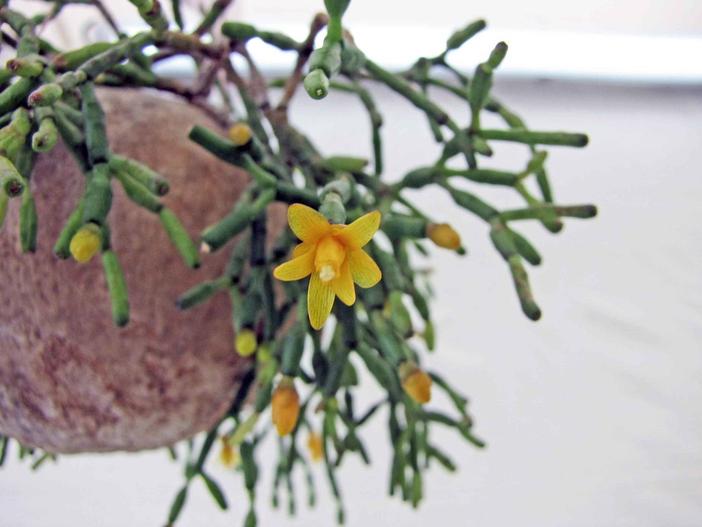Dancing-Bones
(Hatiora salicornioides)
Dancing-Bones (Hatiora salicornioides)
/
/

阿橋花譜 HQ Flower Guide
CC BY-SA 2.0
Image By:
阿橋花譜 HQ Flower Guide
Recorded By:
Copyright:
CC BY-SA 2.0
Copyright Notice:
Photo by: 阿橋花譜 HQ Flower Guide | License Type: CC BY-SA 2.0 | License URL: https://creativecommons.org/licenses/by-sa/2.0/ | Uploader: 阿橋 KHQ | Publisher: Flickr












































Estimated Native Range
Summary
Hatiora salicornioides, commonly known as Dancing-Bones, is an evergreen succulent native to the Atlantic Forest biome in Eastern Brazil, particularly thriving in the humid, shaded understory. This cactus species typically grows to about 1 meter (3 feet) tall and exhibits an erect to pendent growth habit, making it a unique addition to collections. The segmented stems resemble a zigzag pattern, contributing to its common name. The small, bell-shaped yellow to orange flowers, measuring 1–2 cm (0.4–0.8 inches) in both length and diameter, bloom at the ends of younger stem segments and are moderately showy. Following flowering, translucent white berries appear, adding to the plant’s ornamental value.
Dancing-Bones cactus is appreciated for its distinctive growth form and is often used as an indoor ornamental plant. It is relatively easy to maintain, requiring minimal water and thriving in light shade, making it suitable for indoor cultivation or shaded outdoor environments in warm climates. It is not frost-tolerant and prefers a minimum average temperature of 12 °C (54 °F). In regions with cooler winters, it is commonly grown in greenhouses or as a houseplant. The plant benefits from soils with fast drainage and some humidity to mimic its natural habitat. While it is generally pest-free, overwatering can lead to root rot, and it may be susceptible to mealybugs and scale insects if grown in suboptimal conditions.CC BY-SA 4.0
Dancing-Bones cactus is appreciated for its distinctive growth form and is often used as an indoor ornamental plant. It is relatively easy to maintain, requiring minimal water and thriving in light shade, making it suitable for indoor cultivation or shaded outdoor environments in warm climates. It is not frost-tolerant and prefers a minimum average temperature of 12 °C (54 °F). In regions with cooler winters, it is commonly grown in greenhouses or as a houseplant. The plant benefits from soils with fast drainage and some humidity to mimic its natural habitat. While it is generally pest-free, overwatering can lead to root rot, and it may be susceptible to mealybugs and scale insects if grown in suboptimal conditions.CC BY-SA 4.0
Plant Description
- Plant Type: Succulent
- Height: 1-2 feet
- Width: 1-2 feet
- Growth Rate: Moderate
- Flower Color: Yellow, Orange
- Flowering Season: Spring
- Leaf Retention: Evergreen
Growth Requirements
- Sun: Part Shade, Full Shade
- Water: Medium
- Drainage: Fast
Common Uses
Drought Tolerant, Low Maintenance, Street Planting
Natural Habitat
Native to the humid, shaded understory of the Atlantic Forest biome in Eastern Brazil
Other Names
Common Names: Drunkard’s-Dream, Bottle Cactus, Spice Cactus, Conambaia, Glasörtskaktus
Scientific Names: , Hatiora salicornioides, Rhipsalis salicornioides, Rhipsalis bambusoides, Hatiora bambusoides, Hariota bambusoides, Hariota salicornioides, Hatiora salicornioides var. stricta, Hatiora salicornioides var. gracilis, Hatiora salicornioides var. villigera
GBIF Accepted Name: Hatiora salicornioides Britton & Rose